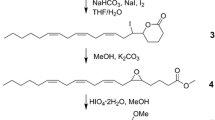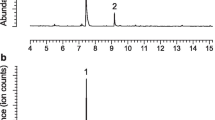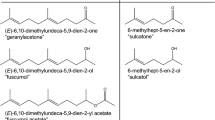Abstract
We describe the identification and field testing of 3-methylthiopropan-1-ol (methionol) as a male-produced aggregation-sex pheromone for the cerambycid beetle Knulliana cincta cincta (Drury) (subfamily Cerambycinae, tribe Bothriospilini). The corresponding sulfoxide, 3-methylsulfinylpropan-1-ol, was also produced sex-specifically by males, but its function remains unclear because the measured release rates of this compound from five different types of release devices were very low to undetectable. Unexpectedly, adults of the cerambycine Elaphidion mucronatum (Say) (Elaphidiini), primarily females, also were attracted by methionol, despite males of this species producing an aggregation-sex pheromone of entirely different structure, (2E,6Z,9Z)-2,6,9-pentadecatrienal.



Similar content being viewed by others
References
Bullas-Appleton E, Kimoto T, Turgeon JJ (2014) Discovery of Trichoferus campestris (Coleoptera: Cerambycidae) in Ontario, Canada and first host record in North America. Can Entomol 146:111–116
Diesel NM, Zou Y, Johnson TD, Diesel DA, Millar JG, Mongold-Diers JA, Hanks LM (2017) The rare North American cerambycid beetle Dryobius sexnotatus shares a novel pyrrole pheromone component with species in Asia and South America. J Chem Ecol 43:739–744
Eyre D, Haack RA (2017) Invasive cerambycid pests and biosecurity measures. In: Wang Q (ed) Cerambycidae of the world: biology and pest management. CRC Press/Taylor & Francis, Boca Raton, pp 563–607
Fierke MK, Skabeikis DD, Millar JG, Teale SA, McElfresh JS, Hanks LM (2012) Identification of a male-produced aggregation pheromone for Monochamus scutellatus scutellatus and an attractant for the congener Monochamus notatus (Coleoptera: Cerambycidae). J Econ Entomol 105:2029–2034
Graham EE, Mitchell RF, Reagel PF, Barbour JD, Millar JG, Hanks LM (2010) Treating panel traps with a fluoropolymer enhances their efficiency in capturing cerambycid beetles. J Econ Entomol 103:641–647
Haack RA, Hérard F, Sun J, Turgeon JJ (2010) Managing invasive populations of Asian longhorned beetle and citrus longhorned beetle: a worldwide perspective. Annu Rev Entomol 55:521–546
Hanks LM, Millar JG (2013) Field bioassays of cerambycid pheromones reveal widespread parsimony of pheromone structures, enhancement by host plant volatiles, and antagonism by components from heterospecifics. Chemoecology 23:21–44
Hanks LM, Millar JG (2016) Sex and aggregation pheromones of cerambycid beetles: basic science and practical applications. J Chem Ecol 42:631–654
Hanks LM, Reagel PF, Mitchell RF, Wong JCH, Meier LR, Silliman CA, Graham EE, Striman BL, Robinson KP, Mongold-Diers JA, Millar JG (2014) Seasonal phenology of the cerambycid beetles of east-Central Illinois. Ann Entomol Soc Am 107:211–226
Hanks LM, Mongold-Diers JA, Mitchell RF, Zou Y, Wong JCH, Meier LR, Johnson TD, Millar JG (2019) The role of minor pheromone components in segregating 14 species of longhorned beetles (Coleoptera: Cerambycidae) of the subfamily Cerambycinae. J Econ Entomol 112:2236–2252
Lacey ES, Moreira JA, Millar JG, Ray AM, Hanks LM (2007) Male-produced aggregation pheromone of the cerambycid beetle Neoclytus mucronatus mucronatus. Entomol Exp Appl 122:171–179
Lacey ES, Millar JG, Moreira JA, Hanks LM (2009) Male-produced aggregation pheromones of the cerambycid beetles Xylotrechus colonus and Sarosesthes fulminans. J Chem Ecol 35:733–740
Lingafelter SW (2007) Illustrated key to the longhorned wood-boring beetles of the eastern United States. Special publication no. 3. Coleopterists society, North Potomac, MD, USA.
Lingafelter SW, Horner NV (1993) The Cerambycidae of north-Central Texas. Coleopt Bull 47:159–191
Linsley EG (1962) The Cerambycidae of North America, part III. Taxonomy and classification of the subfamily Cerambycinae, tribes Opsimini through Megaderini. University of California Publications in Entomology 20. University of California Press, Berkeley, CA, USA
MacRae TC (2000) Review of the genus Purpuricenus Dejean (Coleoptera: Cerambycidae) in North America. Pan-Pac Entomol 76:137–169
MacRae TC, Rice ME (2007) Biological and distributional observations on north American Cerambycidae (Coleoptera). Coleopt Bull 61:227–263
Millar JG, Mitchell RF, Meier LR, Johnson TD, Mongold-Diers JA, Hanks LM (2017) (2E,6Z,9Z)-2,6,9-Pentadecatrienal as a male-produced aggregation-sex pheromone of the cerambycid beetle Elaphidion mucronatum. J Chem Ecol 43:1056–1065
Millar JG, Mitchell RF, Mongold-Diers JA, Zou Y, Bográn CE, Fierke MK, Ginzel MD, Johnson CW, Meeker JR, Poland TM, Ragenovich IR, Hanks LM (2018) Identifying possible pheromones of cerambycid beetles by field testing known pheromone components in four widely separated regions of the United States. J Econ Entomol 111:252–259
Miller DR, Crowe CM, Mayo PD, Silk PJ, Sweeney JD (2015) Responses of Cerambycidae and other insects to traps baited with ethanol, 2,3-hexanediol, and 3,2-hydroxyketone lures in north-Central Georgia. J Econ Entomol 108:2354–2365
Ray AM, Millar JG, McElfresh JS, Swift IP, Barbour JD, Hanks LM (2009) Male-produced aggregation pheromone of the cerambycid beetle Rosalia funebris. J Chem Ecol 35:96–103
Rice ME, Zou Y, Millar JG, Hanks LM (2020) Complex blends of synthetic pheromones are effective multi-species attractants for longhorned beetles (Coleoptera: Cerambycidae). J Econ Entomol 113:2269–2275
SAS Institute (2011) SAS/STAT 9.3 Users Guide. SAS Institute Inc., Cary, NC, USA
Silva WD, Millar JG, Hanks LM, Bento JMS (2016) 10-Methyldodecanal, a novel attractant pheromone produced by males of the South American cerambycid beetle Eburodacrys vittata. PLOS ONE 11:e0160727
Silva WD, Zou Y, Bento JMS, Hanks LM, Millar JG (2017) Aggregation-sex pheromones and likely pheromones of 11 south American cerambycid beetles, and partitioning of pheromone channels. Front Ecol Evol 5:101
Silva WD, Bento JMS, Hanks LM, Millar JG (2018) (Z)-7-Hexadecene is an aggregation-sex pheromone produced by males of the South American cerambycid beetle Susuacanga octoguttata. J Chem Ecol 44:1115–1119
Silva WD, Hanks LM, Bento JMS, Millar JG (2021) 3-Hydroxyhexan-2-one and 3-methylthiopropan-1-ol as pheromone candidates for the south American cerambycid beetles Stizocera phtisica and Chydarteres dimidiatus dimidiatus, and six related species. J Chem Ecol 47:941–949
Švácha P, Lawrence JF (2014) Chapter 2.4 Cerambycidae Latreille, 1802. In: Leschen RAB, Beutel RG (eds) Handbook of zoology: Arthropoda: Insecta: Coleoptera, beetles. Vol. 3: morphology and systematics (Phytophaga). Walter de Gruyter, Berlin/Boston, pp 77–177
Zou Y, Rutledge CE, Nakamuta K, Maier CT, Hanks LM, Richards AB, Lacey ES, Millar JG (2016) Identification of a pheromone component and a critical synergist for the invasive beetle Callidiellum rufipenne (Coleoptera: Cerambycidae). Environ Entomol 45:216–222
Acknowledgments
We thank John Pearson and the Iowa Department of Natural Resources for access to Nine Eagles State Park, and Linnea R. Meier, Todd D. Johnson, Heidi Pierce, Lorenzo D’Alessio, and Aaron Blue for assistance with field work in Illinois. We also thank Ian Swift and personnel from the Los Angeles County Parks who assisted with field work and access to sites in California for T. a. armatum. We appreciate continuous funding support from a series of grants from the United States Department of Agriculture, National Institute for Food and Agriculture (USDA-NIFA) to JGM and LMH during the course of the studies reported here.
Author information
Authors and Affiliations
Contributions
The research was conceived by JGM and LMH, insect-produced chemicals were identified by JGM, JAMD, RFM, and AMR, fieldwork was conducted by MER and ACG, release rates were measured by SH, data were analyzed by LMH, and the manuscript was drafted by LMH and critically revised by all the authors.
Corresponding author
Ethics declarations
This research was funded by a series of grants from the United States Department of Agriculture, National Institute for Food and Agriculture (USDA-NIFA) to JGM and LMH. The authors have no relevant financial or non-financial interests to disclose.
Compliance of Ethical Standards
Additional declarations for articles that report the results of studies involving humans and/or animals: Not applicable.
Ethics Approval
Not applicable.
Consent to Participate
Not applicable.
Consent for Publication
Not applicable.
Conflict of Interest
The authors have no conflicts of interest to declare that are relevant to the content of this article.
Supplementary Information
ESM 1
(DOCX 271 kb)
Rights and permissions
About this article
Cite this article
Rice, M.E., Hanks, L.M., Halloran, S. et al. Methionol, a Sulfur-Containing Pheromone Component from the North American Cerambycid Beetle Knulliana cincta cincta. J Chem Ecol 48, 347–358 (2022). https://doi.org/10.1007/s10886-022-01351-9
Received:
Revised:
Accepted:
Published:
Issue Date:
DOI: https://doi.org/10.1007/s10886-022-01351-9




